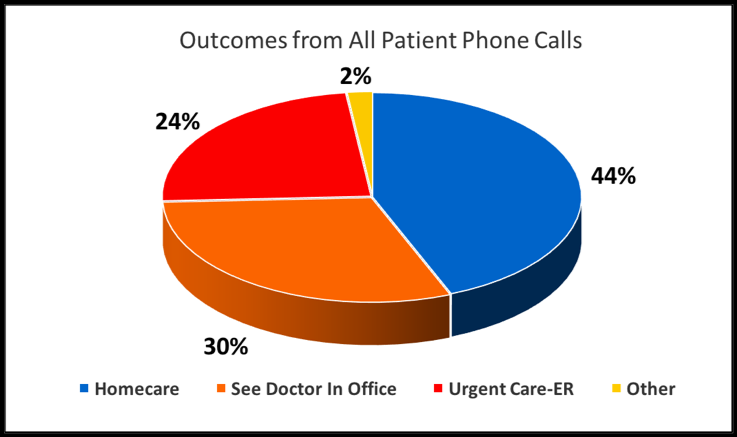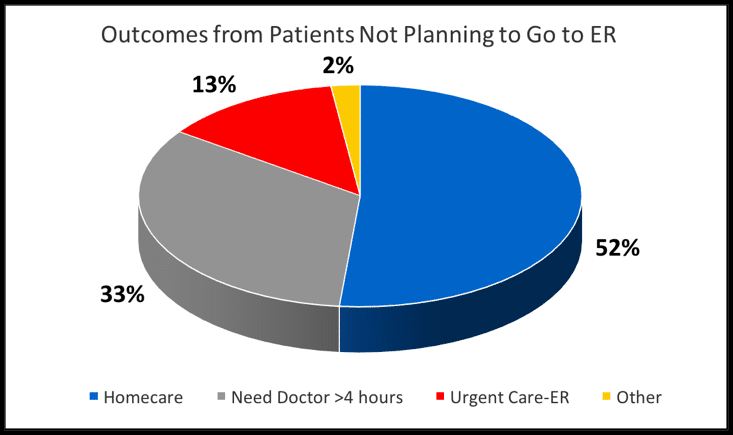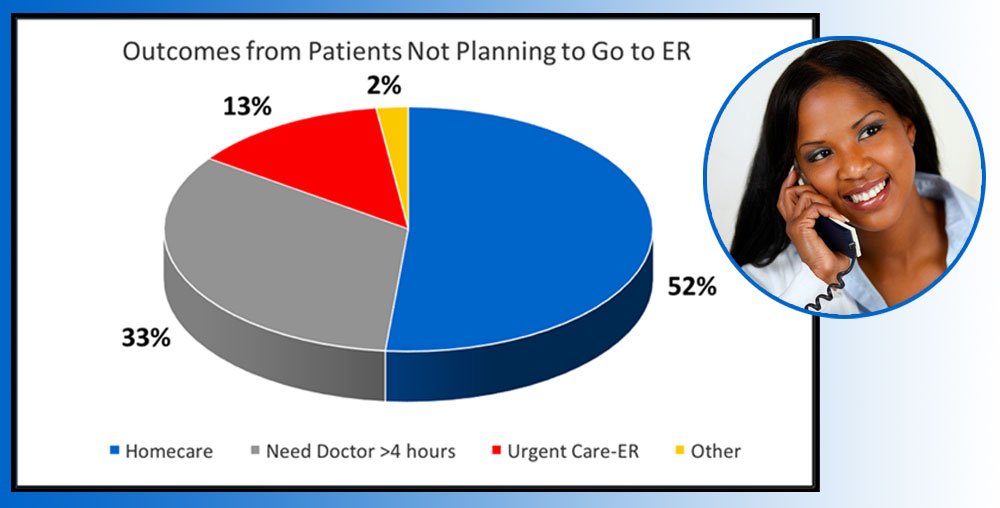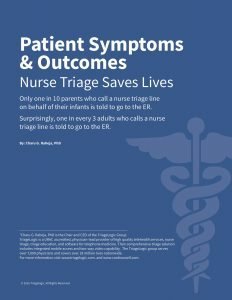Last week we wrote a blog for the top five reasons adults are sent to the Emergency Room (ER) by a triage nurse. This includes shortness of breath, abdominal pain, chest pain, back pain and post-surgery reactions. A question we didn’t address however, is how well were the patients able to determine that they were having serious symptoms prior to calling the nurses? In other words, are triage nurses able to decrease morbidity and mortality by catching patients who would otherwise not go to the ER? We answer this question by looking at the data from our nurse triage center. Surprisingly a significant portion of callers underestimate their symptoms.
We study data from our nurse triage on-call centers. The callers were patients from the doctor practices that use our Nurse Triage on Call service to manage their patient phone calls when the office is closed. We answer the question on the effectiveness of triage nurses in saving morbidity and mortality by including a survey to all of the callers that asks them if they were planning to go to the ER prior to speaking to the triage nurse. We then compared the disposition, or the outcome, from the nurse triage encounter to the responses given by the patients.
The data includes patient dispositions from our nurse triage call center for the months of August and September 2019. In those 2 months, our nurses triaged about 11,000 callers. Nurses ensured that all callers received standardized and high-quality care by using standard, guided triage protocols written by Doctors Schmitt and Thompson. They also skipped the survey if the caller was distressed and it was clear that they needed to call 911.
Outcomes from All Patient Calls
Starting with all of the patient callers, the results are as expected for most nurse telephone triage centers (see Graph 1). A large portion of calls (44%) to the nurse triage service were symptoms that could be treated at home, with no need of further care; this saves additional medical expenses from patients who were planning to go to a medical practice. Further, another 30% were advised to see their doctors within the next few days with no urgent care needed.
Almost a quarter of callers, however, were advised to go to the emergency room or urgent care. Nurses generally advise patients to go to an urgent care clinic to avoid an ER visit if it is safe for the patient. Among these, the symptoms most represented in ER dispositions were similar to our previous studies:
- Abdominal Pain (of which 63% were female and 37% were male)
- Chest Pain
- Cough
- Newborn Acting Sick
- Severe Difficulty Breathing
- Back Pain
Of all the ER dispositions, 7.8% of these were such emergencies that the patients were advised to call 911 so that they could be tended to as quickly as possible.
Graph 1

Of the 11,000 patients that received treatment advice, about 2,600 needed to go to the ER right away. We can conclude from this data that having a nurse triage service with qualified nurses can save lives.
Outcomes from Patients Who Did Not Plan to go to the ER
In addition to the overall care of patients, one of the goals of nurse triage is to improve patient care. We address this question by looking at patients who did not plan to go the ER prior to speaking to the triage nurses. From the 11,000 patients surveyed, a little over 7,900 patients told us that they were not planning to go to the ER. Graph 2 presents the outcomes from these patients who were planning to stay at home.
Graph 2

A full 87% of patients were correct in their self-assessment that they did not have an emergency. From simple medication questions and general information requests to fevers and colds, many of the concerns were of a non-urgent nature that could be handled with home care advise (52%) and in some cases with a visit to the doctor’s office (33%). The remaining 13%, however, had symptoms that urgent attention was needed, either going to an Urgent Care Center or going to the ER. Additionally, 174 patients had such serious symptoms that they were asked to call 911!
The symptoms that comprised these emergency room visits included:
- Abdominal Pain
- Back Pain
- Chest Pain
- Newborn Acting Sick
- Leg Swelling and Edema
Not surprisingly, most of the symptoms that require an ER visit are the same for the All Patients Study as seen in Graph 1, suggesting that better patient education about serious symptoms may help save lives.
These symptoms and percentages may seem familiar; they are rather close to the proportion of total calls that were sent to the emergency room. Proactive patient education about the seriousness of certain symptoms as well as making sure that a 24/7 nurse triage service is available can improve patient outcomes. Patients are not always going to be able to evaluate the seriousness of their symptoms but having a friendly nurse to call for reassurance will encourage the phone call.
Interested in helping your patients by providing them with a trusted nurse triage service when your office is closed? Contact us to learn how we can help you.
Click here to download our e-book “Patient Symptoms & Outcomes: Nurse Triage Saves Lives” for a different survey on patient outcomes from telephone triage calls.







